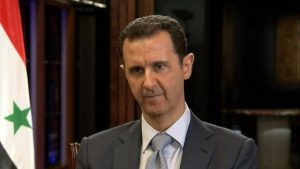Brian M Downing
The term “regime change” once had great attraction. A troubled land would be put on the right path, with American help, and democracy and prosperity would follow. But the ousters of Saddam Hussein and Muammar Qaddafi brought anarchy and havens for Islamist militants, and the idea fell into disrepute.
In recent days, however, President Trump’s UN Ambassador and Secretary of State have called for regime change in Syria. Not a change in ruler, a change in form of government – from a ruthless dictatorship to…well, to something else.
The key to regime change
An attempt at regime change has been underway for six years now. The effort has gone from popular protest to multi-sided warfare. The opposition comprises hardcore Islamists, Salafists, Kurdish defense forces, and various militias backed by Saudi Arabia, Qatar, the US, Turkey, and the Muslim Brotherhood. After years of fighting and hundreds of thousands of deaths, the regime is still there.
International pressure, too, tried to get Assad to step down. This presumably would lead to substantive political change, a more inclusive government, and peace for Syria. But Assad is supported by Iran, Hisbollah, and most critically, by Russia. None are disposed to a new ruler, though Russia is being pressed to change its tune.
Change to what?
If there had been fair elections six years ago, when Syrians filled the streets calling for change, it would have ended Shia control of army, state, and business. This of course was unacceptable to the regime and their sectarian supporters, and the war began.
If fair elections were held today, after years of growing sectarian enmity, a Sunni majority would not only end Shia privilege, it would marginalize the Shias, or drive them into Lebanon and Iraq, perhaps massacring many thousands of them – in the name of Aleppo.
A federal system might seem a workable alternative. A political framework would comprise a Shia state in the west and a number of Sunni-Arab and Kurdish statelets to the east. Central authority would be restricted to managing a common currency, trade policies, and some diplomacy. A central army is unimaginable.
A federation, even a very loose one, isn’t likely. Sectarian hostilities are too high. The Sunni statelets are too antagonistic with one another. The Kurds would naturally gravitate toward kin in Iraq and Turkey, the Arabs toward generous Sunni princes in the Gulf. There would soon be no federation.
Change of ruler
Forcing Bashar Assad from power has attractions. His departure, some maintain, would open the door to dialog and change. At the very least, it would be a symbolic victory. It’s not clear that it would improve matters, though.
 The inner workings of the Assad regime were reasonably well-known under Hafez Assad, father of the current president. He built a powerful apparatus to rule his country and planned to hand it over to his son – Bassel, not Bashir. The former, a colonel, was killed in a 1994 car crash; the latter, an eye doctor, became president upon his father’s death in 2000.
The inner workings of the Assad regime were reasonably well-known under Hafez Assad, father of the current president. He built a powerful apparatus to rule his country and planned to hand it over to his son – Bassel, not Bashir. The former, a colonel, was killed in a 1994 car crash; the latter, an eye doctor, became president upon his father’s death in 2000.
The inner workings of the Assad regime today are not so well known. However, Bashar Assad does not display the competence and command that his father had and that his brother was schooled in. He looks thin and frail, weak and timid – as out of place in an army uniform as Saadam would be in surgical scrubs.
Assad may well have planned and directed sectarian massacres, pitiless military campaigns, and even the use of poison gas at Idlib and elsewhere. The evidence isn’t at hand. He may be a stand-in who never understood Syria or what was holding it together, and an isolated figure who believes the self-serving ideologies of his father’s regime and accepts the word of its generals and ministers.
Though Assad and his regime’s hands are not clean, it isn’t known who holds effective power in Damascus. But those who demand Assad’s departure might ask, in light of the outcomes of recent efforts in the region, if someone worse could take his place.
Copyright 2017 Brian M Downing
Brian M Downing is a national security analyst who has written for outlets across the political spectrum. He studied at Georgetown University and the University of Chicago, and did post-graduate work at Harvard’s Center for International Affairs.